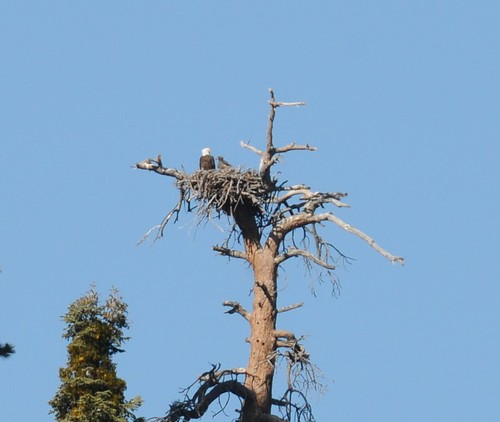A new baby bald eagle will soon begin his flight lessons on the San Bernardino National Forest as the first recorded chick to be successfully nested in recent times near Big Bear Lake.

The chick was first spotted Feb. 21 by Forest Service wildlife biologist Marc Stamer while leading a school field trip. “I was shocked to look through the spotting scope and see a bald eagle chick sitting up in the nest,” said Stamer. “The students, teachers and parents were as excited to see a baby eagle as I was! It was a first for all of us!”
Born around Feb. 11, the chick is nicknamed “Jack” to honor one of the forest’s most dedicated eagle count volunteers, Jack Lubecki, who died several years ago.
The baby eagle’s parents, Lucy and Ricky, built a nest several years ago but had not laid an egg until January --- which surprised local eagle observers and biologists.
The Big Bear Lake area has supported the largest wintering population of bald eagles for many years. Bald eagles migrate to southern California’s lakes and reservoirs for the abundant food supply and then return to nest sites in Oregon, Washington, Montana, Wyoming, Idaho, Alaska, and Canada. Over the past few years, some bald eagles have taken up year-round residency in the Big Bear Lake area.
“We have hoped to see bald eagles nesting in the area for many years since we have great habitat for them,” said Forest Service district biologist Robin Eliason. “Eagles mate for life and will use the same nest tree for several years, so we can expect to see bald eagles here year-round for years to come.”
To minimize disturbance to the new parents and the young eagle, the forest is extending the annual seasonal closure to June 15. During this time it is hoped that the chick will grow and learn to fly without human disturbance. Disturbance around a nest can cause the parents to leave the nest long enough that eggs and/or the chicks are susceptible to predation or can cause the parents to abandon the nest, eggs and chicks.
The Forest Service will use volunteers to both monitor the nest sites and provide the public with opportunities to view the eagles from a safe distance. View this forest news link for more information on volunteering or bald eagle viewing opportunities in the area.
After the eagle’s population decline, it was one of the first animals protected under the federal Endangered Species Act of 1973. After many years of recovery efforts, it was removed from the Endangered Species List but is still considered endangered and a “fully protected species” by the state of California.

